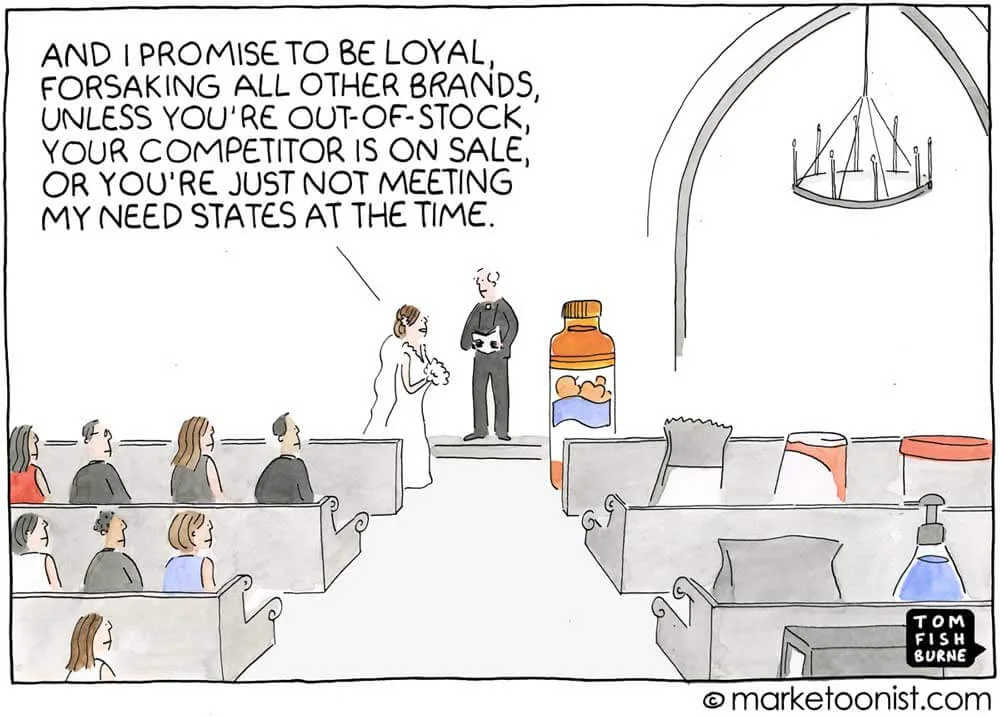The Evolution of Branding: Building Community and Identity
Branding has completely changed over the last hundred years, moving from a simple way to tell one company's products from another's to a deep connection with people's lives and communities. Today, branding isn't just about standing out in the market; it's about creating stories that reflect what people care about. Because of new technology and changes in how we think about shopping, brands now focus on building genuine relationships with their customers. They're not just selling products but fitting into the social scenes of those who buy from them.
This shift means that brands are part of our culture and affect how we see ourselves. For example, when a brand like Patagonia advocates for environmental responsibility, it's not just selling clothes – it's inviting consumers who share those values to join a movement. This is important because it shows that companies can positively impact society, and people want to support brands that positively impact the world around them.
Table of Contents
Defining Branding in a Modern Context

It's not just about a logo or colours; branding now involves the values, ideals, and experiences a brand offers. A strong brand identity connects with customers, creating a feeling of community and loyalty. Instead of just pushing products, successful brands build a world customers want to be part of – one that reflects their values.
Given the rise of social media and the importance of transparency, consumers now have more power. They choose brands that look good, act responsibly, and stand for something positive.
When we talk about creating a brand narrative, it's about telling a story that customers can see themselves in. This storytelling approach is practical because it makes the brand more relatable.
The Importance of Brand Evolution for Market Relevance
When a brand evolves smartly, it stands out, drawing in new folks while keeping loyal customers happy. It's about taking a good look at what your brand stands for, how you talk about it, and what you offer, then tweaking those things to match what people are into. When a brand does this, it shows that it's paying attention and respecting people's choices – something valued nowadays.
Brand evolution is about being bold, innovative, and always thinking about what's next. It's the difference between fading into the background and being the brand everyone's talking about. It's about building a story that evolves with your audience and not just sticking to the same old script.
Historical Perspectives on Branding

Branding started as a way to show who owned something, but it has evolved into complex strategies that draw in customers. Looking back at how branding became before we had digital tech can teach us a lot about changes in marketing and what people want when they shop.
To make this clear, consider how brands used to rely on print ads and word-of-mouth to build their image. Now, they use social media, influencers, and personalised marketing to connect with customers more deeply. All major brands have moved from simple magazine ads to immersive digital campaigns that inspire customer loyalty through storytelling and community engagement.
Using simple language, it's like brands went from saying ‘this is mine' to asking, ‘what can we do for you?' They aim to create a bond with their customers. This is important because a strong brand can turn first-time buyers into lifelong fans.
Origins and Evolution of Branding Concepts
Branding started long ago when craftspeople marked their products to show who made them and to suggest they were of good quality. These early marks grew into symbols that told a story about the maker, setting the stage for what we now call brand heritage. As business increased, having a unique brand became essential. This led to using trademarks to make sure customers could tell products apart.
The logo has become more than just a picture; it reflects what a company stands for and its goals—a crucial part of what's known as narrative branding. This shows how branding has evolved from simple marks to a way to talk to customers and build a community around a brand. As a result, brands can create deep connections with people, making them come back time and again in a competitive market.
The Emergence of Modern Branding Strategies
Today's branding methods have evolved to be more about connecting with people on a personal level than just promoting a product's features. Businesses now understand the importance of being part of their customers' community and creating a shared identity. This means they work to touch hearts and align with values, which helps build a loyal base of customers who feel like they're part of something bigger.
To do this well, companies use real stories, engage with people online, and provide interactive experiences that all contribute to a narrative that's more than just buying and selling. It's about giving customers an experience and inviting them to join a movement or a story that matters. For example, a brand might share customer success stories on social media to show how their product makes a real difference in people's lives.
Branding in the Pre-Digital Era: A Retrospective
Before the rise of the internet, brands built their identities through traditional media channels, focusing on creating logos and slogans that would stick in people's minds. They wanted these symbols to appeal to a broad audience, so they put much effort into making them relatable and memorable. Companies also went to great lengths to legally protect these unique symbols and ensure they were the only ones who could use them for marketing.
As times changed, so did logos, showing how brands adapted to new trends and societal changes. Brands would place their ads in newspapers, radio, and TV, where they knew people were looking for products that would fit their lifestyle and who they wanted to be. It's important to understand these early branding strategies because they laid the groundwork for the techniques that marketers use today.
Technology and Branding in the Digital Age

Digital platforms have changed how brands connect with people. Brands can use detailed data and analysis to make their marketing more effective and build stronger customer relationships. The use of artificial intelligence and machine learning means that brands can offer shoppers a more customised experience that changes to fit their needs.
For instance, a brand like Netflix uses algorithms to suggest shows and movies you might like based on what you've watched before. This exemplifies how AI and machine learning are used in branding to create a personalised experience.
Brands must be clear and relatable in their messaging. Instead of saying, ‘We leverage big data,' a brand could tell, ‘We use your feedback to improve our products.' This gives a reason why collecting data is beneficial to the customer.
Role of Metrics, Analytics, and Big Data in Brand Development
Big data is critical to understanding customers' wants and shaping a successful brand. There are tools to help brands analyse vast amounts of information, gain insights into consumer behaviour, and predict future trends. However, using this data wisely is essential to avoid mistakes and ensure proper analysis.
Here's what brands should focus on:
- Brand metrics: Keep track of how well your brand is doing by monitoring engagement and performance.
- Analytics pitfalls: Be careful not to misread the data or rely too much on numbers that might be incorrect.
- Data-driven storytelling: Use actual data to tell stories that capture people's attention and connect with them.
- Consumer insights: Dive into the data to understand what drives your customers and use that knowledge to make better brand decisions.
- Predictive modelling: Try to predict what customers will want in the future to stay competitive.
By focusing on these points, brands can stay connected with their customers and stand out in a busy market.
Branding and Consumer Psychology
Understanding consumer behaviour and how people see brands is crucial for making a name for yourself in the market. Creating an emotional bond with customers is essential to influencing what they buy and keeping them returning. It is vital to understand why customers stick with a brand, spread the word about it, and don't switch to competitors. This loyalty comes from how brands make them feel and meet their needs.
Creating a smooth narrative is essential, so let's see how these connections work. When people shop, they're not just buying. They often look for something that reflects their identity. A brand that can tap into that, like Apple, emphasising innovation and community, can win over customers in a big way.
Active voice makes this more straightforward: A brand that understands its customers can build a strong relationship. Instead of saying ‘Trust is built,' it's more direct to say, ‘Customers trust brands that listen to them.'
Avoiding exaggeration means sticking to what's true. Rather than saying, ‘Everyone loves brand X,' it's better to point to a survey where 85% of users would recommend brand X to friends.
In a relaxed and persuasive tone, remember that people want to feel like they're in a conversation, not a lecture. Help them see the benefits of what you're saying by using examples they can relate to and language that's easy to understand.
Lastly, avoid terms that might be problematic for better search engine visibility. For example, use ‘replica' instead of ‘fake' when discussing non-genuine products.
The Psychology Behind Brand Loyalty and Trust

Let's explore how companies can build a dedicated customer base through these critical elements:
- Trust Metrics: Brands can gain credibility by being transparent about their practices and ensuring their products are consistently high-quality. For example, a clothing brand that shares detailed information about its sustainable sourcing can earn the trust of environmentally conscious shoppers.
- Loyalty Programs: Offering rewards for repeat purchases can make customers feel valued and more likely to stick with your brand. Think of a coffee shop that gives a free drink after a certain number of purchases—it keeps customers coming back.
- Emotional Connections: When a brand successfully taps into a customer's emotions, they will likely form a bond beyond just buying products. For instance, a pet food brand aligning with animal welfare can resonate deeply with pet owners.
- Consumer Advocacy: Happy customers can become powerful advocates for a brand. If someone loves and raves about a new tech gadget online, their enthusiasm can influence others to check out the brand.
- Brand Psychology: Using psychological insights, brands can shape their identity to reflect what their customers aspire to. A fitness brand that celebrates progress rather than perfection might inspire those on a personal health journey.
Sustainability and Ethical Branding
Nowadays, being green is more than just a buzzword for brands – it's a critical aspect of how they do business. Companies are weaving responsibility for the planet and fair practices into the very fabric of their brands. They've caught on to the fact that people are more likely to support businesses that reflect their ethical standards. This is good for the earth while also helping companies connect with their customers on a deeper level.
In an era where news about climate change and social issues are at the forefront, brands that step up and make a real difference stand out. It's not enough to simply say you're eco-friendly; businesses must show it by reducing waste, using renewable energy, and supporting environmental initiatives.
When a brand recommends a product, like a reusable water bottle made from recycled materials, it's not just selling something – it's advocating for less plastic waste in our oceans. This kind of authentic commitment to sustainability is what resonates with today's consumers.
The Growing Importance of Sustainability in Branding
Today's consumers are savvy and seek companies that discuss sustainability and make it a core part of their business strategies. This consumer preference has highlighted the importance of several key sustainability concepts:
- Green marketing involves promoting products or services based on their eco-friendly benefits.
- Eco Eco-consciousness refers to a brand's awareness and action towards reducing its environmental footprint.
- Sustainable innovation is the development of new products and processes that prioritise long-term ecological health.
- The circular economy is a model where products are designed for reuse, repair, and recycling rather than ending up as waste.
- Renewable materials can be replenished naturally and used in manufacturing to reduce environmental harm.
Brands that genuinely grasp and practice these sustainability principles are doing their part for the planet and, as a result, are seeing more customers stick with them.
Ethical Practices and Social Responsibility in Brand Identity

Consumers today increasingly hold companies accountable for their actions, demanding that they operate transparently and responsibly. As a result, brands are under close watch to ensure they source materials ethically and engage in fair trade, safeguarding human rights and the environment. This heightened consumer awareness is steering businesses towards a more accountable stance on social and environmental issues.
Companies must genuinely integrate sustainability into their business practices to win over customers and stay competitive, rather than just using it as a marketing ploy. This means going beyond token gestures to avoid the trap of greenwashing, where actions are more about appearance than actual impact.
Customers seek brands that talk and walk the walk regarding ethical conduct. For instance, a clothing brand that uses organic materials and pays fair wages to its workers is more likely to be supported by eco-conscious consumers. Or a company that shares its carbon footprint reduction targets – and meets them – can make a strong statement about its dedication to the environment.
Sustainability in Branding and Community Engagement
When reflecting on how ethical behaviour shapes a brand's reputation, it's vital to delve into how businesses weave sustainability into their brand identity and local engagement. Companies increasingly lean toward sustainable efforts to fulfil a duty and shape their brand around environmental consciousness. By participating in local projects, businesses can tackle their ecological footprint in ways that resonate with customers, prioritising autonomy and mindful living.
• Eco-friendly Practices: Embedding green methods in operations and offering sustainable products.
• Local Partnerships: Collaborating with community organisations to promote ecological health.
• Reducing Impact: Reducing emissions and resource use, like how water conservation efforts influenced water bills in Brisbane.
• Ethical Commitments: Upholding responsible sourcing and supporting fair trade initiatives.
• Eco-branding: Utilising environmental certifications to strengthen the brand's public perception.
Such strategies confirm a brand's role as a dedicated caretaker of the environment.
Building Community and Engagement
Creating a solid community and keeping people engaged in today's market is essential for a brand's success. Social media is a crucial place for building this community. Being open and honest helps a brand earn trust and support. Also, working with influencers and sharing content made by customers are effective ways to strengthen a brand's community and deepen bonds with customers.
Utilising Social Media for Community Building and Engagement
In today's connected world, using social media smartly is vital to bringing people together and keeping them engaged. Brands now have to do more than just post updates; they must also listen and talk back to what their audience is saying. This two-way conversation, social listening, helps them address what matters to their community.
Instead of just hoping their content will go viral, brands must craft messages that genuinely resonate with their audience. Choosing the right social media platforms is crucial because it's about meeting people where they already hang out and share their interests.
Keeping an eye on likes, comments, and shares – the engagement metrics – tells brands whether they are hitting the mark. It's like having a direct line to customer feedback without asking for it.
To get people talking, creating a hashtag campaign can work wonders. It's a way to rally the troops around a topic they care about. For example, a brand could jump on Earth Day celebrations with a #GoGreenWithUs campaign, encouraging users to share their eco-friendly actions.
Fostering Transparency, Authenticity, and Brand Advocacy

Being transparent about where your products come from and how your business operates is now a must to gain customer trust. This openness shows that a company stands behind its actions, making people feel secure in their choices.
Moreover, when customers are encouraged to talk about their experiences with your brand, it does more than spread a positive message. It strengthens the sense of community. For instance, if a clothing brand uses organic cotton, sharing how and where they source it can engage customers who care about sustainable practices.
Authenticity and transparency are essential in today's market. Programs that enable customers to become brand ambassadors are crucial. They get the word out and reinforce the brand's and customers' relationship.
The Role of Influencers and User-Generated Content in Community Building
Social media figures are critical players in building thriving brand communities. Brands tap into the power of influencers, recognising that content from these individuals can resonate with specific groups and help create a genuine connection with the brand.
- Working with influencers: It's about more than just pairing up with popular users; it's about creating authentic content that truly speaks to the people you want to reach.
- Spreading content: When users share content, it's like a vote of confidence, helping a brand's message travel far and wide and bringing more people into the community fold.
- Clever use of social media tools: To get the most out of social media, brands must understand how platform algorithms work. This know-how can help bring their content in front of more eyes.
- Hashtag campaigns: When brands create unique hashtags, they allow customers to join the conversation, turning a simple purchase into a shared experience.
- Measuring engagement: Keeping an eye on the numbers—likes, shares, comments—helps brands understand what's working and what's not, allowing them to make smarter decisions about their community-building efforts.
Conclusion
In today's fast-paced world, the importance of community and identity in branding cannot be overstated. Successful brands go beyond the product to create a sense of loyalty and advocacy through meaningful engagement. This evolution of branding emphasises creating experiences and stories that resonate with individuals personally, promoting a feeling of shared purpose and connection.
